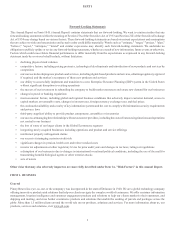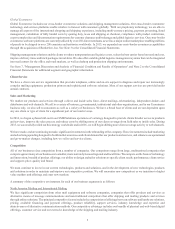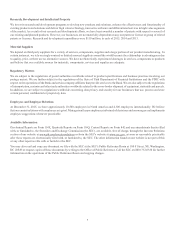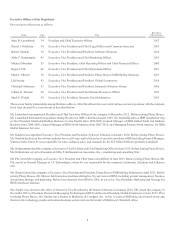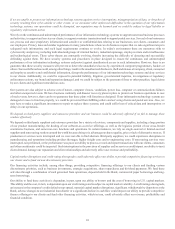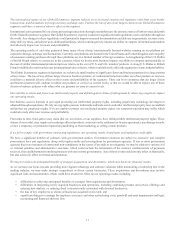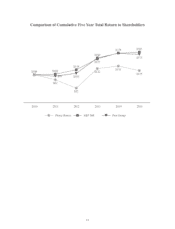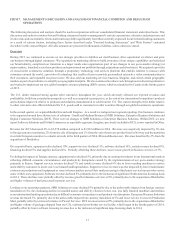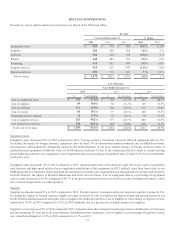Pitney Bowes 2015 Annual Report Download - page 25
Download and view the complete annual report
Please find page 25 of the 2015 Pitney Bowes annual report below. You can navigate through the pages in the report by either clicking on the pages listed below, or by using the keyword search tool below to find specific information within the annual report.9
Mr. Wright joined the company as Executive Vice President and President, Pitney Bowes Software Solutions in April 2013. He was
elected Executive Vice President and President, Pitney Bowes Digital Commerce Solutions in February 2014. In January 2016 he was
elected Executive Vice President, Strategic Growth Initiatives. Before joining Pitney Bowes, Mr. Wright served as Executive Vice
President, Enterprise Solutions Group for Infor Global Solutions.
ITEM 1A. RISK FACTORS
Our operations face certain risks that should be considered in evaluating our business. We manage and mitigate these risks on a proactive
basis, including through the use of an enterprise risk management program. Nevertheless, the following risk factors, some of which may
be beyond our control, could materially impact our business, financial condition, results of operations, brand and reputation, and may
cause future results to be materially different than our current expectations. These risk factors are not intended to be all inclusive.
We are subject to postal regulations and processes, which could adversely affect our revenue and profitability.
A significant portion of our revenue and profitability is directly or indirectly subject to regulation and oversight by postal authorities
worldwide. We depend on a healthy postal sector in the geographic markets where we do business, which could be influenced positively
or negatively by legislative or regulatory changes in those countries. Our revenue and profitability in a particular country could be affected
by adverse changes in postal regulations, the business processes and practices of individual posts, the decision of a post to enter into
particular markets in direct competition with us and the impact of any of these changes on postal competitors that do not use our products
or services. These changes could affect product specifications, service offerings, client behavior and the overall mailing industry.
If we are not able to respond to the continuing decline in the volume of physical mail delivered via traditional postal services, our results
of operations and profitability could be adversely impacted.
Declining mail volumes has had an adverse impact on our revenues and profitability and is expected to continue to influence our revenue
and profitability in the future. We continue to employ strategies for stabilizing the mailing business which include new product and service
offerings, transitioning our current products and services to more digital offerings and providing our clients broader access to products
and services through online and direct sales channels. There is no guarantee that these offerings will be widely accepted in the marketplace,
and they will likely face competition from existing and emerging alternative products and services.
Further, an accelerated or sudden decline in physical mail volumes could have an adverse effect on our mailing business. An accelerated
or sudden decline could result from, among other things, changes in our clients' communication behavior, changes in communication
technologies or legislation or regulations that mandate electronic substitution, prohibit certain types of mailings, increase the difficulty
of using information or materials in the mail, or impose higher taxes or fees on mailing or postal services.
If we are not successful at meeting the continuing challenges faced in our mailing business, or if physical mail volumes were to experience
an accelerated or sudden decline, our financial results could be negatively impacted.
We may not realize the anticipated benefits from our implementation of a new Enterprise Resource Planning (ERP) system, and the
transition to the new ERP system may not be uninterrupted or error-free.
We have made, and will continue to make, significant investments in the development and implementation of a new ERP system that is
expected to provide operating cost savings through the elimination of redundant systems and strategic efficiencies through the use of a
standardized, integrated system. In the fourth quarter of 2015, we completed the implementation of the ERP system for our Canadian
operations and will begin implementing this system in the U.S. in 2016. If the implementation of the ERP system in the U.S. is not
successful, or is delayed, the expected operating cost savings and strategic efficiencies may be delayed or may not be obtained or sustainable
and may prevent us from introducing new products or services.
Further, the transition to the new ERP system will affect numerous systems necessary for the company's operation. If we fail to correctly
implement one or more components of the ERP system, we could experience significant disruption to our operations. Such disruptions
could include, among other things, temporary loss of data, inability to process certain orders, failure of systems to communicate with
each other and the inability to track or reconcile key data.






